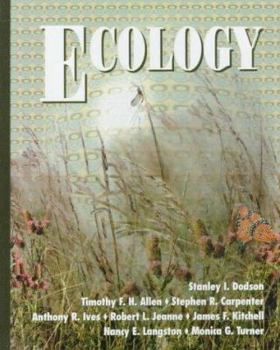Ecology
Complex and diverse, modern ecology is often difficult to introduce to undergraduate students in a way that conveys the excitement and enthusiasm that ecologists feel for their field. In this text, the authors aim to encourage students by adopting a new approach to teaching modern ecology, dividing the field into several distinct subdisciplines, each with its own way of looking at the world...
Unique and accessible, Ecology concentrates on the ideas and techniques that separate different concept-based approaches to the study of ecology. It discusses six kinds of ecology: landscape, physiological, ecosystem, population, community, and behavioral, focusing on the kinds of questions ecologists ask about their world rather than on accumulated ecological knowledge. For each type of ecology, the authors explore how it is distinct, the theory and technology involved, and its successes and possibilities for the future. Each chapter discusses the roles of evolution and of modeling in that particular kind of ecology, and also emphasizes that there are important questions ecologists do not yet have the answers to. These questions encourage students to consider pursuing the study of ecology because there is still much significant work to be done. The authors, all experts in specific areas of ecology, strive to inspire students by communicating the excitement they feel about their respective fields of study and by actively involving students in the learning process. The discussions are set in the context of the human relationship to nature and include practical applications of ecology, such as resource management and conservation.
Easily accessible to undergraduate students in general ecology, this brief, up-to-date, and lucidly written text is an ideal starting place for learning ecology. It sets ecology in its cultural context and encourages students to see ecology happening all around them, opening their eyes to the wide range of possibilities in the field and providing them with a firm basis for further reading and for choosing advanced courses and careers. The text will soon be enhanced by helpful supplemental material: the authors are currently in the process of developing a website (which will include the art from the book, lab and field experiments, data sets, and sample tests) and a book of readings to accompany the text.
Unique and accessible, Ecology concentrates on the ideas and techniques that separate different concept-based approaches to the study of ecology. It discusses six kinds of ecology: landscape, physiological, ecosystem, population, community, and behavioral, focusing on the kinds of questions ecologists ask about their world rather than on accumulated ecological knowledge. For each type of ecology, the authors explore how it is distinct, the theory and technology involved, and its successes and possibilities for the future. Each chapter discusses the roles of evolution and of modeling in that particular kind of ecology, and also emphasizes that there are important questions ecologists do not yet have the answers to. These questions encourage students to consider pursuing the study of ecology because there is still much significant work to be done. The authors, all experts in specific areas of ecology, strive to inspire students by communicating the excitement they feel about their respective fields of study and by actively involving students in the learning process. The discussions are set in the context of the human relationship to nature and include practical applications of ecology, such as resource management and conservation.
Easily accessible to undergraduate students in general ecology, this brief, up-to-date, and lucidly written text is an ideal starting place for learning ecology. It sets ecology in its cultural context and encourages students to see ecology happening all around them, opening their eyes to the wide range of possibilities in the field and providing them with a firm basis for further reading and for choosing advanced courses and careers. The text will soon be enhanced by helpful supplemental material: the authors are currently in the process of developing a website (which will include the art from the book, lab and field experiments, data sets, and sample tests) and a book of readings to accompany the text.
Format:Hardcover
Language:English
ISBN:0195120795
ISBN13:9780195120790
Release Date:March 1998
Publisher:Oxford University Press, USA
Length:464 Pages
Weight:2.05 lbs.
Dimensions:0.9" x 7.6" x 9.5"
Customer Reviews
2 ratings
I like it
Published by Thriftbooks.com User , 16 years ago
I really like the way they organize this book. For me, a environmental management study person, this book gives a very clear sketch of Ecology. It also very good to read articles from so many good ecologist from diferent angles. I strongly recommand this book to those who want to know what have been discussed and covered in the subject of Ecology, and how we can link these ideas and knowledge to our life or other studies.
A fine and readable survey of academic ecology
Published by Thriftbooks.com User , 21 years ago
This book presents a survey of the academic subdivisions of the science of ecology. Gives some general information and then a chapter on each of 6 different specializations in the science, viz., landscape, ecosystem, physiological, behavioral, population and community ecology, written by pofessional ecologists. Especially valuable for someone wishing to study ecology in school who wonders what exactly the various subfields deal with and consist of. Also enjoyable for anyone wanting to learn about the aims, problems, approaches and results of ecology as an academic endeavor. Includes sections on how the subfields are linked together. Includes a glossary and many references.






